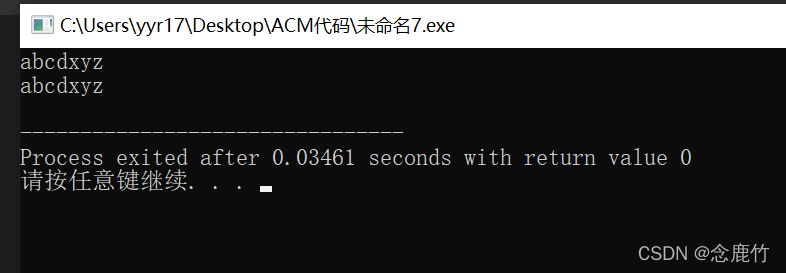目录
在C语言中,一般使用字符数组 char str[]来存放字符串,但是使用字符串数组有时会显得操作麻烦,在C++中加入了string类型。
注意,如果要使用string,需要添加 string头文件,即# include<string> (注意 string. h 和 string 是不一样的头文件)。除此之外,还需要在头文件下面加上一句:“ using namespace std"。
即:
#include<string>
using namespace std;
1.string 的定义
定义和初始化和普通的数据类型一样:
string str;//定义变量
string str="abcd";//初始化2.string 中内容的访问
(1)通过下标访问
一般来说,可以直接像字符数组那样去访问string。
程序代码:
#include<bits/stdc++.h>//万能头文件,里面包含头文件<string>
#include<string>
using namespace std;
int main(){
string str = "hello";
for(int i=0;i<str.length();i++){
printf("%c ",str[i]);
}
return 0;
}运行结果:

如果要读入和输出整个字符串,则只能用cin和cout.
程序代码:
//#include<bits/stdc++.h>
//万能头文件,里面包含头文件<string> 和 <iostream>
#include<iostream>//cin和cout在iostream头文件中,而不是stdio.h
#include<string>
using namespace std;
int main(){
string str;
cin>>str;
cout<<str<<endl;
return 0;
}运行结果:

(2)通过迭代器访问
一般仅通过(1)就可以满足访问的要求,但是有些函数比如insert()和erase()则要求以迭代器为参数,所以还是学一下迭代器的用法。
定义string迭代器:
string::iterator it;
这样就可以得到迭代器it,并且可以通过*it来访问string里的每一位:
程序代码:
#include<cstdio>
#include<string>
using namespace std;
int main(){
string str = "abcd";
for(string::iterator it = str.begin();it !=str.end();it++) {
printf("%c",*it);
}
return 0;
}运行结果:

3.string 常用函数实例解析
(1)operator+=
这是string 的加法,可以将两个string直接拼接起来。
示例如下:
#include<iostream>
#include<string>
using namespace std;
int main(){
string str1= "abcd",str2="xyz",str3;
str3=str1+str2;//将str1和str2拼接,赋值给str3
str1+=str2;//将str2直接拼接到str1上
cout<<str1<<endl;
cout<<str3<<endl;
return 0;
}输出结果:

(2) length()/size()
length()返回string的长度,即存放的字符数,时间复杂度为O(1)。size()与length()基本相同。
示例如下:
string str="abcxyz";
printf("%d %d\n"),str.length,str.size());
输出结果:
6 6
(3) insert()
insert(pos,string),在pos号位置插入字符串string。
示例如下:
#include<iostream>
#include<string>
using namespace std;
int main(){
string str = "nihaoshijie";
str.insert(2, "**");
cout<<str<<endl;
return 0;
}输出结果:

(4) erase()
- 删除单个元素
str.erase(it)用于删除单个元素,it为需要删除元素的迭代器。
示例如下:
#include<iostream>
#include<string>
using namespace std;
int main(){
string str = "abcdefg";
str.erase(str.begin()+4);//删除4号位(即e)
cout<<str<<endl;
return 0;
}输出结果:

- 删除一个区间内的所有元素有元素
str.erase(pos,length),其中pos为需要开始删除的起始位置, length为删除的字符个数。
示例如下:
#include<iostream>
#include<string>
using namespace std;
int main(){
string str = "abcdefg";
str.erase(3,2);//删除从3号位开始的2个字符,即de
cout<<str<<endl;
return 0;
}输出结果:

(5) clear()
clear()用以清空string中的数据,时间复杂度一般为O(1)。
代码示例:
#include<iostream>
#include<string>
using namespace std;
int main(){
string str = "youdianlei";
str.clear(); //清空字符串
cout<<str.length()<<endl;
return 0;
}输出结果:

(6) string::npos
string:npos是一个常数,其本身的值为-1,但由于是 unsigned_int类型,因此实际上也可以认为是unsigned_int类型的最大值。string:npos用以作为find函数失配时的返回值。
(7) find()
str.find(str2),当str2是str的子串时,返回其在str中第一次出现的位置;如果str2不是str的子串,那么返回 string::npos。
str.find(str2,pos),从str的pos号位开始匹配str2,返回值与上相同。时间复杂度为O(nm),其中n和m分别为str和str2的长度。
示例如下:
输出结果:

声明:本文内容摘自胡凡、曾磊老师主编的《算法笔记》书本内容。